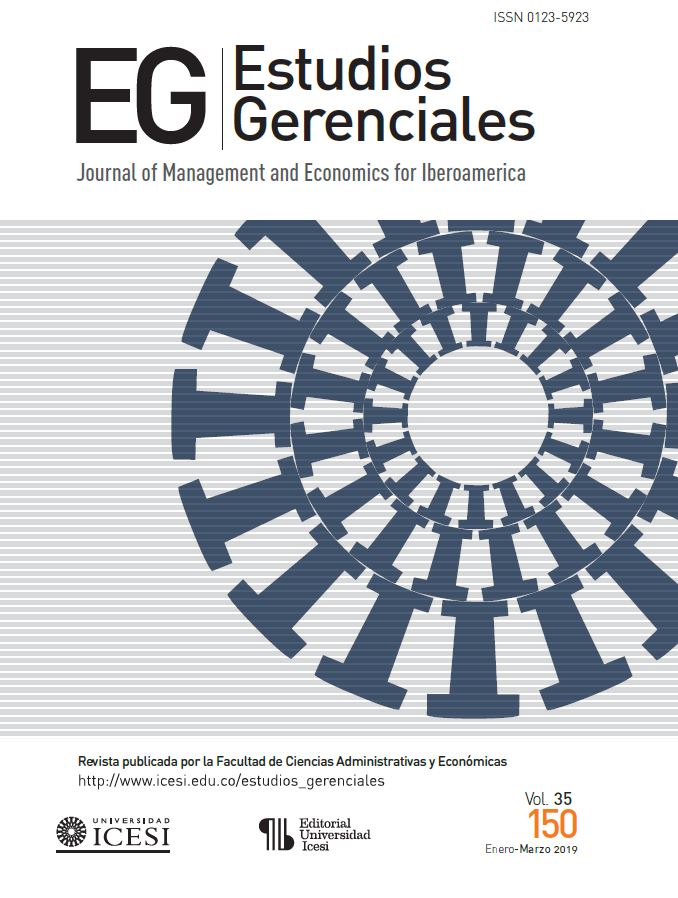Medium-sized firms in Peru: a review of capital budgeting practices
DOI:
https://doi.org/10.18046/j.estger.2019.150.2943Keywords:
Capital budgeting, Discount rate, Net present value, Payback period, Cash flowAbstract
The objective of this article is to know what are the techniques used by medium-sized companies to evaluate their investment projects, and in this way to determine if there is a gap between theory and practice. In addition, we sought to identify which characteristics of the company and its general manager influence the use of these techniques. For this, a survey was elaborated and applied to 126 medium-sized companies in the department of Piura (Peru). Based on this, it was found that a large part of the sample uses at least one technique where cash flows are discounted, which is supported by the theory; therefore, it is evident that the gap between theory and practice is not very wide.
Downloads
References
Andor, G., Mohanty, S. K. y Toth, T. (2011). Capital budgeting practices: a survey of Central and Eastern European firms.Emerging Markets Review, 23, 148-172. http://dx.doi.org/10.1016/j.ememar.2015.04.002
Apap, A. y Masson, D. J. (2005). A survey of capital budgeting in publicly traded utility companies.Southwest Business and Economics Journal, 13(1), 45-52.
Arnold, G. C. y Hatzopoulos, P. D. (2000). The theory-practice gap in capital budgeting: evidence from the United Kingdom.Journal of Business Finance & Accounting, 27(5-6), 603-626. http://dx.doi.org/10.1111/1468-5957.00327
Batra, R. y Verma, S. (2017). Capital budgeting practices in Indian companies. IIMB Management Review, 29(1), 29-44. http://dx.doi.org/10.1016/j.iimb.2017.02.001
Berk, J. B. y DeMarzo, P. M. (2007).Corporate finance (third edition). Boston: Pearson Education.
Brijlal, P. y Quesada, L. (2009). The use of capital budgeting techniques in businesses: a perspective from the Western Cape. The Journal of Applied Business Research, 25(4), 37-46. http://dx.doi.org/10.19030/jabr.v25i4.1015
Brounen, D., De Jong, A. y Koedijk, K. (2004). Corporate finance in Europe: confronting theory with practice. Financial Management, 33(4), 71-101. http://dx.doi.org/10.2139/ssrn.559415
De Andrés, P., De la Fuente, G. y San Martín, P. (2012). El director financiero y la decisión de inversión en la empresa española.Universia Business Review, 4(36) 14-30.
De Souza, P. y Lunkes, R. J. (2016). Capital budgeting practices by large Brazilian companies.Contaduría y Administración, 61(3), 514-534. http://dx.doi.org/10.1016/j.cya.2016.01.001
El-Daour, J. I. y Abu Shaaban, M. (2014). The use of capital budgeting techniques in evaluating investment projects: an applied study on the Palestinian corporations working in Gaza Strip.Journal of Al-Quds Open University for Research & Studies, 32, 9-50. http://dx.doi.org/10.12816/0016064
Elumilade, D. O., Asaolu, T. O. y Ologunde, A. O. (2006). Capital budgeting and economic development in the third world: the case of Nigeria.International Research Journal of Finance and Economics, 2(2), 136-152.
Graham, J. R. y Harvey, C. R. (2001). The theory and practice of corporate finance: evidence from the field.Journal of financial economics, 60(2), 187-243. http://dx.doi.org/10.1016/S0304-405X(01)00044-7
Haddad, K., Sterk, W. y Wu, A. (2010). Capital budgeting practices of Taiwanese firms.Journal of International Management Studies, 5(1), 178-182.
Hermes, N., Smid, P. y Yao, L. (2005). Capital budgeting practices: a comparative study of the Netherlands and China.International Business Review, 16(5), 630-654. http://dx.doi.org/10.1016/j.ibusrev.2007.05.002
Kengatharan, L. (2016). Capital budgeting theory and practice: a review and agenda for future research.Applied Economics and Finance, 3(2), 15-38. http://dx.doi.org/10.11114/aef.v3i2.1261
Lazaridis, I. T. (2004). Capital budgeting practices: a survey in the firms in Cyprus.Journal of small business management, 42(4), 427-433. http://dx.doi.org/10.1111/j.1540-627X.2004.00121.x
Maquieira, C. P., Preve, L. A. y Sarria-Allende, V. (2012). Theory and practice of corporate finance: evidence and distinctive features in Latin America.Emerging Markets Review, 13(2), 118-148. http://dx.doi.org/10.1016/j.ememar.2011.11.001
Mongrut, S. y Wong, D. (2005). Un examen empírico de las prácticas de presupuesto de capital en el Perú.Estudios gerenciales, 21(95), 95-111.
Myers, S., Allen, F. y Brealey, R. (2010). Principios de finanzas corporativas (4 ed.).México DF: Mc Graw Hill.
Ochoa, J. y Mora, A. M. (2014). Prácticas de presupuesto de capital: evaluación empírica en un grupo de empresas del sector de la construcción en Colombia.Ecos de Economía, 18(39), 143-163.
Pereiro, L. y Galli, M. (2000). La determinación del costo del capital en la valuación de empresas de capital cerrado: una guía práctica. Trabajo de investigación. Buenos Aires: Instituto Argentino de Ejecutivos de Finanzas y Universidad Torcuato Di Tella.
Ross, S., Westerfield, R. y Jaffe, J. (2012). Finanzas corporativas (9 ed.). México DF: Mc Graw Hill .
Ryan, P. A. y Ryan, G. P. (2002). Capital budgeting practices of the Fortune 1000: how have things changed?Journal of business and Management, 8(4), 355-364.
Shinoda, T. (2010). Capital budgeting management practices in Japan: a focus on the use of capital budgeting methods.Economic Journal of Hokkaido University, 39, 39-50.
Truong, G., Partington, G. y Peat, M. (2008). Cost-of-capital estimation and capital-budgeting practice in Australia.Australian Journal of Management, 33(1), 95-121. http://dx.doi.org/10.1177/031289620803300106
Vecino, C. E., Rojas, S. C. y Muñoz, Y. (2015). Prácticas de evaluación financiera de inversiones en Colombia.Estudios Gerenciales, 31(134), 41-49. http://dx.doi.org/10.1016/j.estger.2014.08.002
Wnuk-Pel, T. (2014). The practice and factors determining the selection of capital budgeting methods-evidence from the field.Procedia Social and Behavioral Sciences, 156, 612-616. https://doi.org/10.1016/j.sbspro.2014.11.250
Downloads
Published
Issue
Section
License
Articles are the sole responsibility of their authors, and will not compromise Icesi’s University principles or policies nor those of the Editorial Board of the journal Estudios Gerenciales. Authors authorize and accept the transfer of all rights to the journal, both for its print and electronic publication. After an article is published, it may be reproduced without previous permission of the author or the journal but the author(s), year, title, volume, number and range of pages of the publication must be mentioned. In addition, Estudios Gerenciales must be mentioned as the source (please, refrain from using Revista Estudios Gerenciales).








